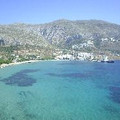的点评
Fabulous fountain
Fuente del Rey的点评
点评:At the southwestern end of the town, and easily reached by following the splendid Calle Río, which is a street with many fine Baroque doorways, lies the fabulous, stunning Fuente del Rey, a spectacular 180-jet fountain (with many later additions) which pours water into a number of basins. It was completed in 1803, but building of it started supposedly in the 16th Century. The highest of these has a sculpture of a lion struggling with a serpent, whilst the second contains a larger late eighteenth-century depiction of Neptune and Amphitrite, the king and queen of the sea. Amphitrite is clutching the dolphin that returned her to Neptune after her attempted escape, incidentally, emphasizing the power of the king, the work’s intended ideological message, given that over the border in France, monarchs were losing their heads.
One guidebook has called it one of the most tranquil squares in Andalucía, and it is hard not to see this tree shaded area being a wonderful place to relax and get away from it all on a hot summer’s day, cooled by the flowing water. The noise of the water is also therapeutic. This must be why there are so many marble benches to sit on all round the fountain.
One guidebook has called it one of the most tranquil squares in Andalucía, and it is hard not to see this tree shaded area being a wonderful place to relax and get away from it all on a hot summer’s day, cooled by the flowing water. The noise of the water is also therapeutic. This must be why there are so many marble benches to sit on all round the fountain.
翻译:在小镇的西南端,沿着壮丽的 Calle Río 街很容易到达,这条街有许多精美的巴洛克风格门廊,坐落着令人叹为观止的 Fuente del Rey,这是一座壮观的 180 喷口喷泉(后来又进行了许多扩建),将水喷入多个水池中。它于 1803 年完工,但据说建造于 16 世纪。其中最高的一座是狮子与蛇搏斗的雕塑,而第二座是十八世纪晚期的海王和海后安菲特里特的更大雕像。安菲特里特抓着海豚,海豚在她试图逃跑后将她送回了海王身边,顺便强调了国王的力量,这是该作品想要传达的意识形态信息,因为在法国边境,君主们正在失去理智。
一本旅游指南称它是安达卢西亚最宁静的广场之一,在炎热的夏日,流水带来的清凉让人不禁想到这片绿树成荫的地区是放松身心、远离尘嚣的绝佳去处。水声也有治疗作用。这肯定就是为什么喷泉周围有这么多大理石长椅可以坐的原因。
一本旅游指南称它是安达卢西亚最宁静的广场之一,在炎热的夏日,流水带来的清凉让人不禁想到这片绿树成荫的地区是放松身心、远离尘嚣的绝佳去处。水声也有治疗作用。这肯定就是为什么喷泉周围有这么多大理石长椅可以坐的原因。
此点评仅代表旅行者个人的主观意见,并不代表TripAdvisor以及其合作方的意见。
关于我们
|新闻动态
|商务合作
|会员中心
|业主中心
|常见问题
|意见反馈
|联系我们
|营业执照
© 2025 Tripadvisor 版权所有。
使用条款 |隐私政策 |网站工作原理
部分照片由 VFM Leonardo 提供。
* Tripadvisor不是旅行社,也不是旅游预订服务代理商。我们提供免费、客观、公正的旅游资讯服务。 (显示更多)
TripAdvisor LLC 既不是预订代理商,也不是旅游运营商,不会向网站用户收取任何服务费。 按照规定,在 Tripadvisor 发布机票价格、游览和旅行套餐的合作伙伴(航空公司、旅行提供商及预订代理商),其标价须包含所有费用和附加费用。 例如, 机场出入境税费、消费税与其他服务费、手续费、杂费及附加费用。 当您向我们的某个合作伙伴进行预订时,请务必查阅他们的网站以了解当地行政部门要求的所有适用费用的具体情况。 除非另有说明,机票价格通常指的是一个人的价格(以人民币计)。
为方便起见,TripAdvisor LLC 根据从我们的预订合作伙伴获取的空房率计算每个酒店的均价。 对于游览和景点来说,所显示价格通常是每位成人的最低可用价格。 对于列出的任何旅行套餐或优惠,TripAdvisor LLC 无法保证任何特定的费率或价格。 此外,酒店均价每晚会更新,并以您的首选币种表示(使用现行汇率)。 由于这些已换算的价格是预估价格,因此,有关具体金额和币种请与预订网站进行核实。
此外,TripAdvisor LLC 无法保证我们网站上宣传的价格随时有效。 标价可能需要预订一定天数才能生效,或有不可用日期、使用条件或限制。
TripAdvisor公司对外部网站的内容一概不负责。优惠价格中不含税和其他费用。
ICP证:沪B2-20200433
沪ICP备20013175号
 沪公网安备31010502005427号
沪公网安备31010502005427号鹰程信息技术(上海)有限公司
货币/国家及地区
¥CNY
中国

